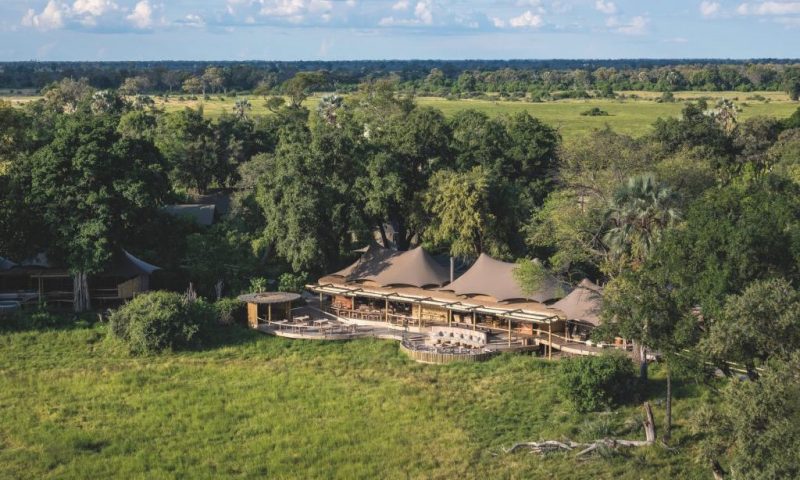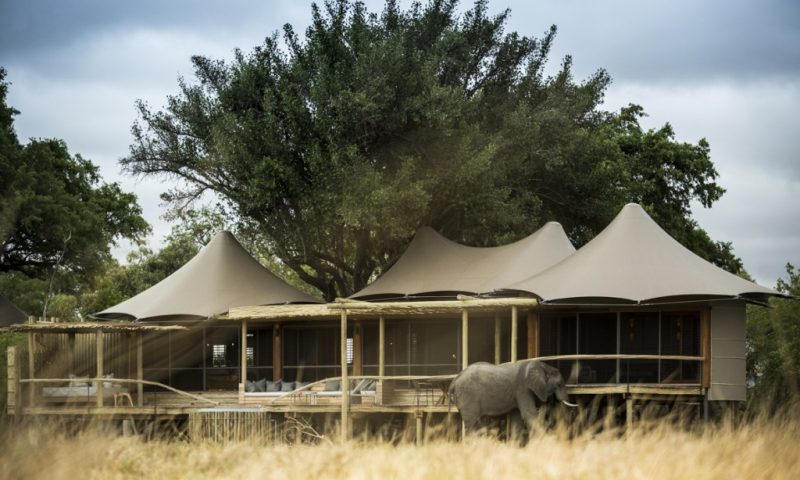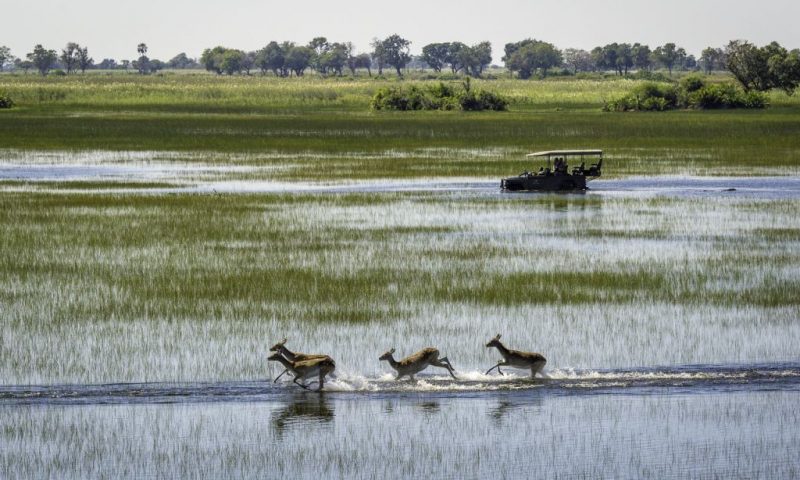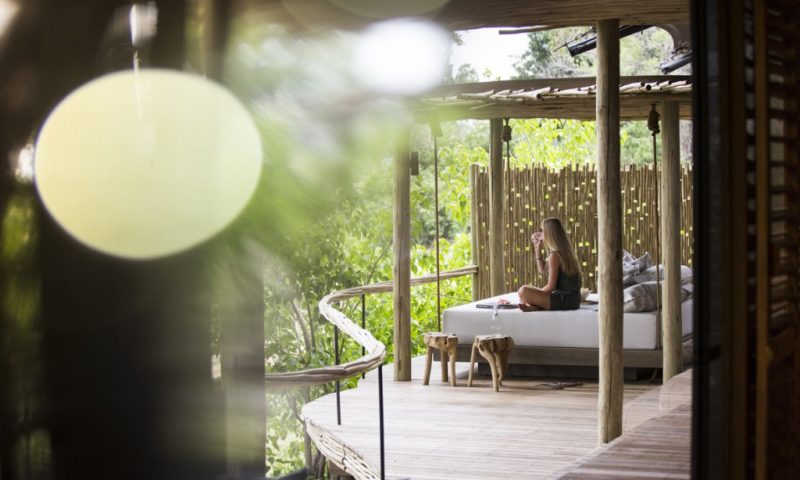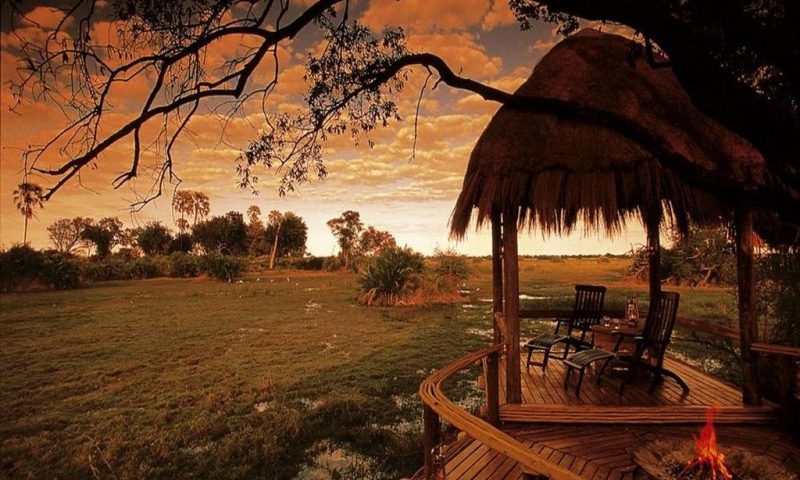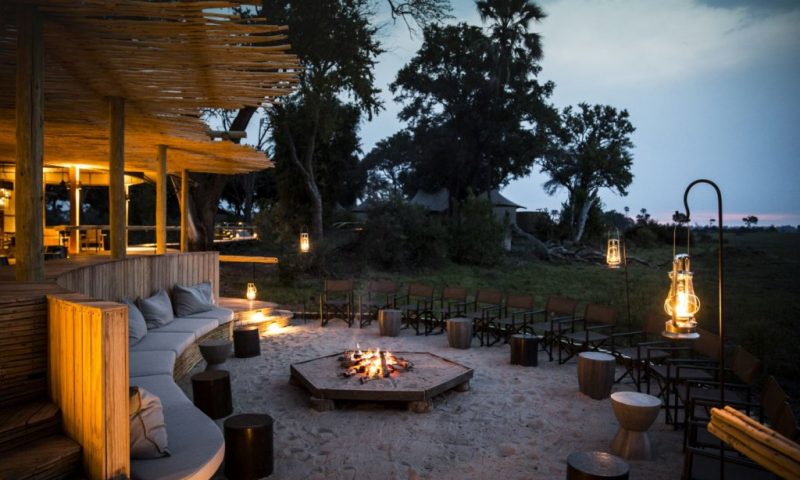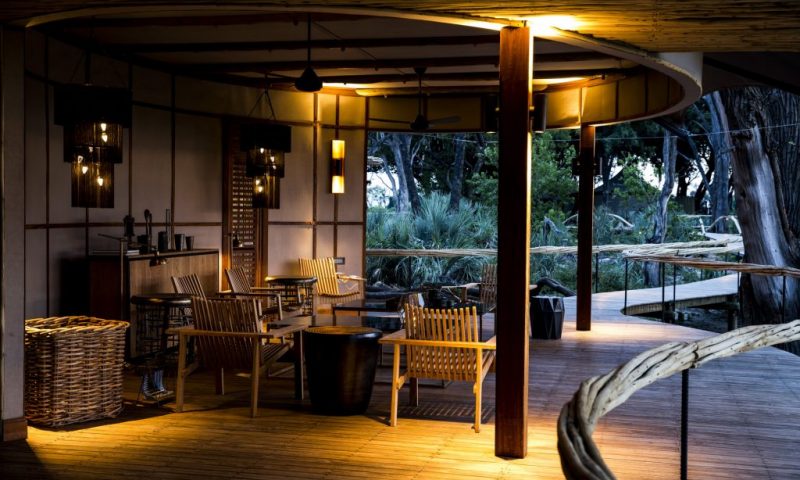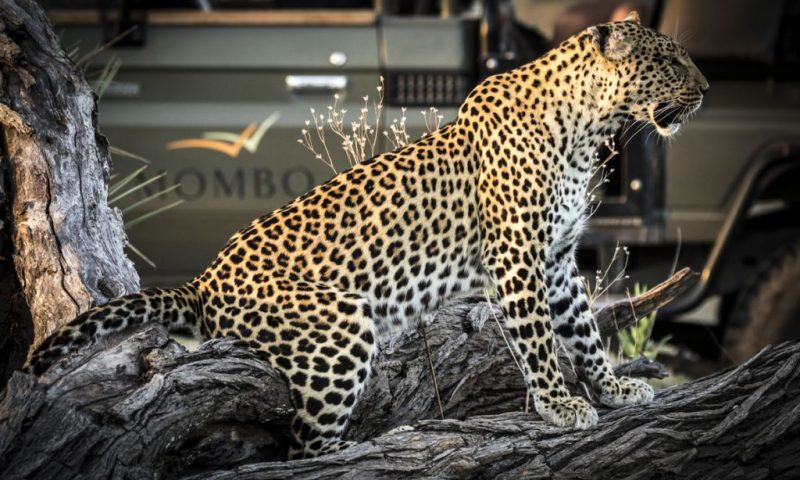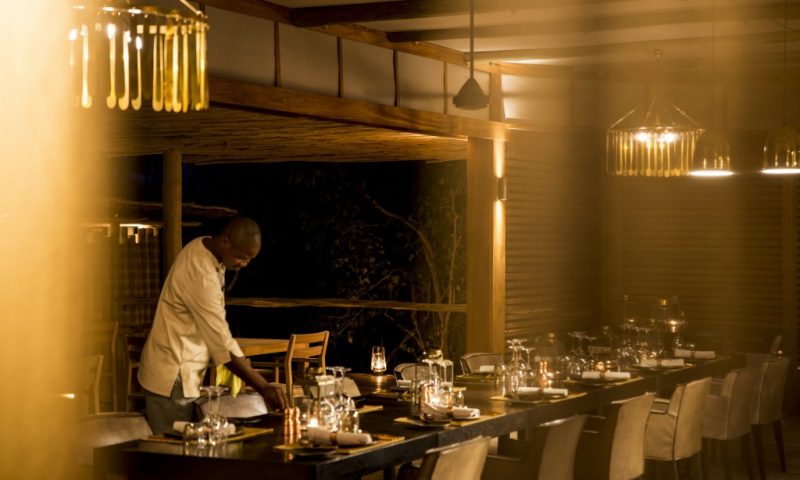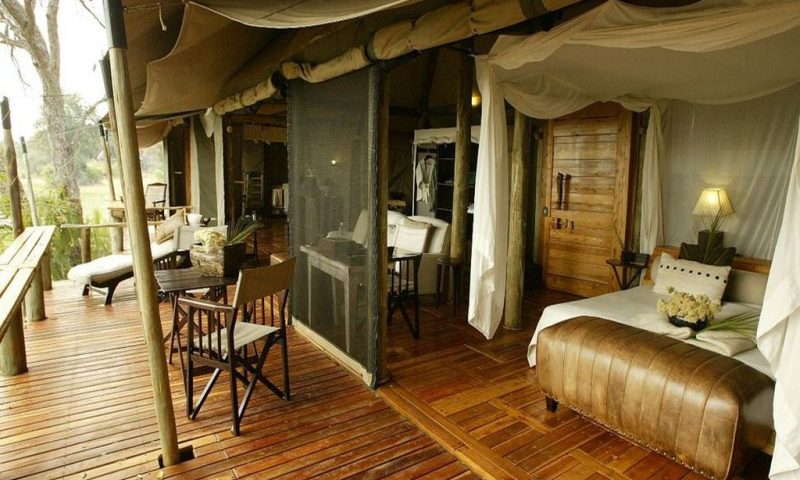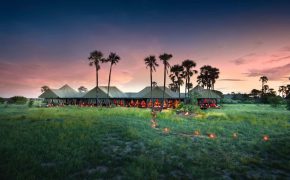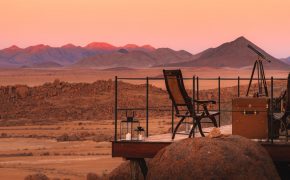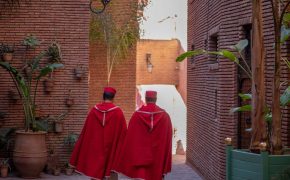Located in the heart of Botswana’s Okavango Delta, Mombo Camp is the flagship property of the Wilderness Safaris. Mombo camp is widely recognised as the finest safari camp in Africa with its incredible game concentrations and interactions as well having a unique approach to luxury hospitality.
Newly rebuilt in 2019, the concept of Mombo Camp is to maintain the Mombo traditions and history stretching back nearly 30 years, as well as to celebrate possibly one of the greatest conservation successes: the reintroduction of black and white rhino into the wilds of Botswana.
The nine large tented suites (including a family room) are elevated above the ground, so that those views can be enjoyed from the veranda and pergola. Each tent has been built in exactly the same place as its predecessor – with a slight increase in size out towards the floodplain to facilitate a pool deck with a private plunge pool.
Inside, a sitting room, separate bedroom and bathroom, indoor and outdoor showers and a bathtub with copper and brass finishings all contribute to the Wilderness ideal of responsible luxury. In completion, Mombo is a camp that seemingly dissolves into its environment, capturing the essence, spirit and feeling of its surroundings.
By paying specific attention to the finer details at Mombo it becomes evident just how the designers conceptualised the smallest factors; guests will notice a colonial under current; sherry decanters, military chests, brass lamps and writing desks coupled with a naturalist feel created by wicker furniture, reed blinds, porcupine lampshades, Kuba and Show cloths and original inspirations such as pygmy beds from the Congo that have been converted into coffee tables!
The result is an eclectic mixture of old and new that compliments the diversity of Mombo’s habitat and subtly caters for every lavish want.
THE OKAVANGO DELTA
Botswana’s Okavango Delta has to be one of the most incredible places to view wildlife in the world. As a wetland paradise, containing roughly 95 percent of Botswana’s surface water located within the arid Kalahari Desert, this unique eco-system is an area of unbelievable natural beauty.
Each year, flood waters from the Angolan highlands come down in two main thrusts ending in the Kalahari desert, spreading over a vast area creating a wetland paradise that supports a huge diversity of flora and fauna including swamps, reed beds, flood plains, vast papyrus beds and long stretches of clear water, filtered through the sand until it is fine enough to drink.
As the water floods out, peaking in August time, from the air the fan shaped waterways creates what we know as the Okavango Delta. The heart of the Okavango Delta is the Moremi Game Reserve, an area of land that is mostly dry throughout the year.
On its circumference however are hundreds of palm fringed islands truly untouched and deserted offering some of Africa’s last pristine game viewing environments. Mombo is built on one of these islands and although part of the Moremi Game Reserve, is at its Northern most point and therefore is affected by the flood levels of the Okavango itself.
At Mombo, the flood waters usually arrive at the end of April and last until the end of August. In 2019, the Okavango Delta has an unusual draught which has not been seen in many years.
However, 2020 is set to be one of the best years yet, and we are thrilled to see the Delta back in full swing creating those dreamy scenes and exceptional wildlife habitats which it is so famed for. The flood is therefore expected to last through until September.
MOREMI GAME RESERVE
Well regarded as one of Africa’s finest and most beautiful reserves the Moremi Game Reserve covers an area of untouched wilderness including approximately twenty percent of the Okavango Delta itself.
Reachable by a 30 minute flight from Maun and located in the centre of the Okavango Delta, Moremi is principally made up of two large landmasses; Chiefs Island and the Mopane Tongue.
The reserve has a wide diversity of ecosystems ranging from dense mopane woodland and acacia forests to vast floodplains and lagoons. This broad range of habitat creates a stunning place to be on safari but the game here is the principle attraction; Moremi is widely acknowledged as the predator capital of the world.
Literally teeming with other game, the reserve is also the only place in Botswana where the big five can be seen. Elephant and both species of rhino are present along with good herds of buffalo, wildebeest and zebra.
Plenty of antelope such as waterbuck, kudu and red lechwe provide ample opportunity for the vast numbers of predators with large prides of lion, leopard and cheetah regularly spotted on game drives along with resident packs of wild dog and hyena.
Game viewing in the reserve is at its peak from July to October when the areas rainfall dries up and animals start focusing around the areas of permanent water.
As the Delta floods evaporate from around September and temperatures rocket, the plains dry up and lush grass is left in their wake providing fresh supplies for the resident game and excellent photographic opportunities for those on safari.
High season is not the time to be in Moremi for every kind of traveller as there are also incredibly opportunities in the greener months.
WHEN TO GO
Many people ask us when the best time of year is to be at Mombo for the best wildlife viewing. The answer is simply impossible to give, there are benefits to each time of year and to each season.
Peak season is from July to October, but there is no doubt that Mombo, Little Mombo and this surrounding area of the Moremi Game Reserve provides consistently stunning game viewing all year round. One of the main reasons is that the vast majority of wildlife around Mombo is resident, roaming throughout the Moremi concession but rarely leaving it.
The predators for example, especially lion and leopard, (which have made Mombo so well known) are resident to the Mombo Concession and have become well known to the guides in camp; they can be seen throughout the year.
Overall, it is true to say that Mombo has some of the best safari in Africa for the entirety of the year. The concentrations of all the predators and plains game fluctuates but not to a significantly noticeable effect.
As one client once said, ‘if I were an animal this is where I’d live!’ and the reality is that that is true; the vast majority of game really has no reason to leave.
WEATHER
Weather wise, Botswana’s climate is subtropical with large fluctuations of temperature between day and night and low rainfall throughout the year. September and October are the hottest months, with temperatures peaking at over 40 degrees Celsius in October.
This time of year also heralds the arrival of the very first rains that continues through to March, petering out at the end of the month. The wettest months are January and February.
With all that said, and taking into consideration the fact that you will not just be visiting Mombo, the best time of year to visit the country is between May and October, when the Delta is in flood, the temperature is perfect and game viewing is at its most spectacular.
If you look at April and May, you can get reduced rates and an equally brilliant and beautiful Delta experience as to high season when you pay double the price. November and December also make great times to be on safari because of the noticeable transformation of the habitat and all the newborn that spring to life at the first drop of rain.
PASSAPORTS & VISA
International visitors require a valid passport together with onward travel documents. Guests must please ensure that their passport is valid for at least 6 months after their entry date and that they have a minimum of 2 blank pages (if there is insufficient space in the passport then entry will be denied) in their passport to enable the entry visa to be issued.
In addition if a father (or mother) is travelling with his (her) children alone then a letter of consent, certified by their local police, must be signed by the mother (father) and carried with them.
All passport holders should verify with their travel agent or relevant consulate concerning visa entry requirements. If you are extending your journey to other countries, please establish entry requirements for those countries as well.
LUGGAGE RESTRICTIONS
The luggage restrictions to Mombo are strictly a maximum of 20kg per guest. There are strict weight restrictions in place on any itinerary in Botswana including light aircraft transfers for the following reasons:
- The aircraft are designed with a maximum bodyweight and luggage weight allowance.
- Most of the airfields in Botswana are over 3000 feet above sea level and are located in the tropics, and therefore the permissible aircraft carrying capacity is reduced.
- The aircraft have physical space restrictions.
Notes for fly-in safaris:
- Only soft bags (no hard suitcases as they physically cannot fit into the aircraft) will be accepted. This includes camera equipment and hand luggage.
- The maximum dimensions of the soft bags are as follows: 81cm long x 36cm wide. Please keep in mind that the baggage compartments on the light aircraft are only 25cm high, so the pilots must have the ability to manipulate the bag into the compartment.
- Passengers weighing more than 100kg or more, or two guests travelling together whose combined weight is 200kgs, must please advise us in advance as an extra seat will then have to be costed in to the package for safety purposes.
These luggage restrictions for luggage sound like very little but bear in mind the following:
- Most safari camps / lodges and hotels provide basic toilet amenities. Laundry can be done on a daily basis (and many camps provide this service free of charge but hotels do charge a nominal fee). Mainly casual clothing is required as no formal clothes are needed at Mombo and throughout Botswana, we recommend that you limit your luggage to the basics.
CLOTHING
On Safari – informal and casual dress is appropriate. Comfortable lightweight cotton clothing in subdued safari colours is practical. During the day, shorts or trousers are ideal, and the evenings may be chilly so light cardigans or sweaters are appropriate.
Sometimes, in the peak season months (Botswana’s winter and our summer!) a fleece or two should be packed for chilly campfire nights. Long sleeved shirts and trousers are also advisable in the evenings to lessen the chance of being bitten by mosquitoes.
Many safari lodges have swimming pools, so bathing costumes should be taken. It is advisable to have a good pair of closed walking shoes / boots.
PHOTOGRAPHY
The choice of the correct camera equipment and film will determine the quality of your photographs on the trip. For good photography of birds and animals, a good SLR camera and telephoto lens is necessary.
A zoom lens can be extremely useful on safari and the minimum recommended size is 200mm. Consideration should be given before travelling with any lens bigger than 400 mm as most interesting shots are taken using hand held equipment.
The new high-resolution digital cameras are outstanding and give great quality images, especially if you are using a digital camera body which takes normal camera lenses. Camera bodies like the Canon D60 and 1D are superb.
The advantage of digital photography is that one can get instant feedback and adjustments can be made in the field to your techniques to ensure that your photographs are the quality that you would like.
Colour reversal film (slides) will give far better quality than prints. The guides have found that they are getting the best results using Fuji film. Fuji has brought out a good high-speed film that gives good colour with very little grain (less so than any of their competitors).
This is especially useful when using a big lens in low light situations. The guides’ personal preference is the slower film (either 50 or 100 ASA) as this gives almost perfect quality for normal light.
However, you may consider going to 200 ASA for a larger lens in low lighting conditions. The new Fuji 400, we believe is giving great results too. The only disadvantage with the low ASA film is that you need a tripod for the early morning and evening shots.
HEALTH
There are a few basic health matters that require care and attention. We are obviously not medical practitioners and the following points are recommended guidelines only. Please consult your doctor and also check with your health department prior to departure for any changes in health regulations.
MALARIA
Malaria can be found throughout much of Botswana. Should you be visiting these areas malaria precautions are advised. Malaria transmission is at its highest during the warmer and wetter months of November through to April.
From May through to October the risks of acquiring malaria are reduced. The malaria parasite requires a human host in order to complete its life cycle.
In most cases, our camps are situated in remote, unpopulated areas, so the chances of contracting malaria are very slim. Nonetheless, it is worth taking preventative measures. Both chloroquine-resistant and normal strains of malaria are prevalent in Africa.
Malaria is transmitted by a very small percentage of female Anopheles mosquitoes. They are only active in the early evening and throughout the night, at the times when one is usually sleeping or sitting around the campfire.
Expert opinion differs regarding the best approach to malaria prophylaxis. It is important to bear in mind that malaria may be contracted despite chemoprophylaxis, especially in areas where chloroquine resistance has been reported.
Please remember that the best insurance is the preventative kind: avoid being bitten by using mosquito repellents liberally. Wear long-sleeved shirts and trousers/slacks in the evenings. If staying in a bungalow or tent, spray with an insecticide like DOOM to kill any mosquitoes that may have flown into your room. Mosquito coils are effective.
If you become ill on your return, while still on prophylaxis or even once you have stopped taking them, ensure that your doctor does everything to establish that your illness is not malaria.
Malaria is not a serious problem if you are sensible and take basic precautions. There have been very few cases of our guests contracting malaria during our 19 years to date, of operation.
WATER
It is very important that you drink plenty of water especially during the warmer months. It is generally recommended that guests drink at least 2 to 3 litres (4 to 6 pints) of water per day to limit the effects of dehydration.
This excludes tea, coffee and alcoholic beverages, which act as diuretics and can actually contribute to dehydration. Generally, water throughout Southern Africa is safe to drink directly from the tap. However, bottled water is readily available, so please do not allow yourself to become dehydrated.
STOMACH UPSETS
It is advisable to carry medication supplied by your physician for simple stomach upsets. In the first few days of your trip you may suffer from mild upsets attributable to a change in food and water. We do recommend that you consult your doctor about other recommended injections, normally the advice is that Typhoid and Hepatitis injections should be taken.
CAMP INFORMATION
Mombo is situated in one of the most remote areas of the Okavango and we have to generate our own electricity.
WIFI
Mombo Camp and Little Mombo both have excellent Wifi available in your rooms only.
POWER AT MOMBO
Each camp has a generator which runs for about 6 – 7 hours per day (split between morning and afternoon when guests are out on activities). In most camps, these generators then charge a bank of batteries known as an invertor system which then provides 220v power in each tented room for lighting and ceiling fans.
Mombo and Little Mombo have 220v plug points in the tents but these can be used for the charging of batteries only. Guests should please ensure that if they want batteries charged, then they need to bring a spare battery for use while the other is being charged as well as a power converter if applicable as our power is all 220v.
All camps have the following adaptors: 3 prong round, 3 prong square, 2 prong round and 2 prong flat. It is not possible to use appliances such as hairdryers or electric shavers in the tented rooms at Mombo as they have low wattage fuses which will trip.
DRINKS POLICY
All drinks are included in the nightly tariff, with the exception of premium wines & champagne, and premium liqueurs & spirits.
LAUNDRY POLICY
Laundry is done on a daily basis and inclusive in the nightly tariff. “Smalls” are washed in a smaller, individual bag.
EXTRAS PAYMENT
Curios, imported drinks and tips/gratuities can be billed to the tent number and settled on check out. Payment can be effected by cash (US$), travellers’ cheques or the following credit cards: Visa or MasterCard.
THE PEOPLE
The indigenous people of the country are friendly and hospitable. They are rightly proud of their country, so be sensitive as you would be anywhere in your travels.
CURRENCY
Botswana’s currency is the Pula. You will be able to change foreign exchange at the bank at the airport and also at any other banks in the major towns throughout Botswana.
US dollars are often favoured, and most excursions throughout the country, tips in camp, drinks and curios can be paid for in dollars. We advise clients to take spending money in the form of US dollars cash or travellers cheques. Credit cards are also widely accepted.
